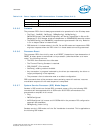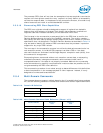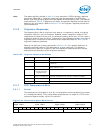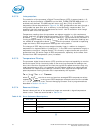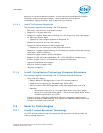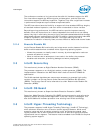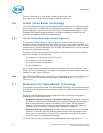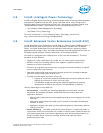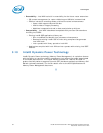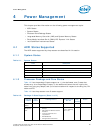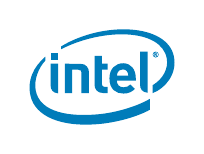
Technologies
78 Intel® Xeon® Processor E5-1600 v2/E5-2600 v2 Product Families
Datasheet Volume One of Two
3.1.2 Intel® VT-x Features
The processor core supports the following Intel VT-x features:
• Extended Page Tables (EPT)
— hardware assisted page table virtualization
— eliminates VM exits from guest OS to the VMM for shadow page-table
maintenance
• Virtual Processor IDs (VPID)
— Ability to assign a VM ID to tag processor core hardware structures (for
example, TLBs)
— This avoids flushes on VM transitions to give a lower-cost VM transition time
and an overall reduction in virtualization overhead.
• Guest Preemption Timer
— Mechanism for a VMM to preempt the execution of a guest OS after an amount
of time specified by the VMM. The VMM sets a timer value before entering a
guest
— The feature aids VMM developers in flexibility and Quality of Service (QoS)
guarantees
• Descriptor-Table Exiting
— Descriptor-table exiting allows a VMM to protect a guest OS from internal
(malicious software based) attack by preventing relocation of key system data
structures like IDT (interrupt descriptor table), GDT (global descriptor table),
LDT (local descriptor table), and TSS (task segment selector).
— A VMM using this feature can intercept (by a VM exit) attempts to
relocate these data structures and prevent them from being tampered by
malicious software.
• Pause Loop Exiting (PLE)
— PLE aims to improve virtualization performance and enhance the scaling of
virtual machines with multiple virtual processors
— PLE attempts to detect lock-holder preemption in a VM and helps the VMM to
make better scheduling decisions
• APIC Virtualization (APICv)
— APICv adds hardware support in the processor to reduce the overhead of virtual
interrupt processing (APIC accesses and interrupt delivery). This benefits
mostly interrupt intensive workloads.
— In a virtualized environment the virtual machine manager (VMM) must emulate
nearly all guest OS accesses to the advanced programmable interrupt
controller (APIC) registers which requires “VM exits” (time-consuming
transitions to the VMM for emulation and back). These exits are a major source
of overhead in a virtual environment. Intel's Advanced Programmable Interrupt
Controller virtualization (APICv) reduces the number of exits by redirecting
most guest OS APIC reads/writes to a virtual-APIC page to allow most reads to
occur without VM exits.
3.1.3 Intel® VT-d Objectives
The key Intel VT-d objectives are domain-based isolation and hardware-based
virtualization. A domain can be abstractly defined as an isolated environment in a
platform to which a subset of host physical memory is allocated. Virtualization allows
for the creation of one or more partitions on a single system. This could be multiple




